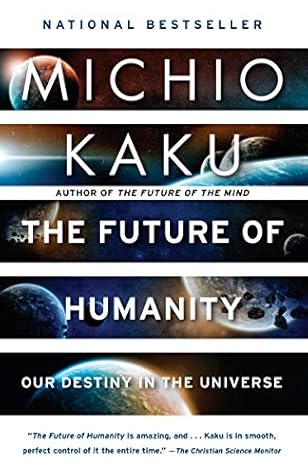More on this book
Community
Kindle Notes & Highlights
by
Michio Kaku
Read between
May 29 - June 7, 2019
Geneticists have noticed the curious fact that any two humans have almost identical DNA. By contrast, any two chimpanzees can have more genetic variation between them than is found in the entire human population. Mathematically, one theory to explain this phenomenon is to assume that, at the time of the explosion, most humans were wiped out, leaving only a handful of us—about two thousand people.
The Earth has already sustained five major extinction cycles, in which up to 90 percent of all life-forms vanished from the Earth.
there might be twenty billion Earth-sized planets orbiting a sun-like star in our galaxy alone. And since there are one hundred billion galaxies that can be seen with our instruments, we can estimate how many Earth-sized planets there are in the visible universe: a staggering two billion trillion.
History reveals that scientific revolutions come in waves, often stimulated by advances in physics. In the nineteenth century, the first wave of science and technology was made possible by physicists who created the theory of mechanics and thermodynamics. This enabled engineers to produce the steam engine, leading to the locomotive and the industrial revolution. This profound shift in technology lifted civilization from the curse of ignorance, backbreaking labor, and poverty and took us into the machine age.
In the twenty-first century, the third wave of science has been expressed in high tech, spearheaded by the quantum physicists who invented the transistor and the laser. This made possible the supercomputer, the internet, modern telecommunications, GPS, and the explosion of the tiny chips that have permeated every aspect of our lives.
fourth wave of science, which consists of artificial intelligence, nanotechnology, and biotechnology.
Since science is the engine of prosperity, nations that turn their backs on science and technology eventually enter a downward spiral.
The experience of weightlessness is caused by the fact that everything falls at the same rate. So an astronaut inside the spaceship would fall at the same rate as his ship and experience the illusion that gravity has been turned off.)
Recently, scientists have revealed some of the deepest secrets of the aging process. After centuries of false starts, there are now a few reliable, testable theories that seem promising. These involve caloric restriction, telomerase, and age genes.
If we die and our connectome lives on, then are we in some sense immortal? If our mind can be digitized, then is the soul just information?
(There are two types of gene therapy, somatic cell gene therapy, where non-sex cells are modified, so that the mutations do not spread to the next generation, and germ-line gene therapy, where your sex cells are altered so that all your descendants can inherit the modified gene.) Germ-line gene therapy could, if unchecked, alter the genetic heritage of the human race.
These are examples of “transhumanism,” which advocates embracing technology to enhance our skills and capabilities.
Physicist Paul Davies goes one step further: “My conclusion is a startling one. I think it very likely—in fact inevitable—that biological intelligence is only a transitory phenomenon, a fleeting phase in the evolution of intelligence in the universe. If we ever encounter extraterrestrial intelligence, I believe it is overwhelmingly likely to be post-biological in nature, a conclusion that has obvious and far-reaching ramifications for SETI [the search for extraterrestrial intelligence].”
In Norse mythology, the Twilight of the Gods is called Ragnarok, the day of reckoning, when the world is blanketed in unending snow and ice and the heavens freeze over.
According to Einstein’s theory of relativity, there are two sources of energy that drive the evolution of the universe. The first is the curvature of space-time, which creates the familiar gravity fields surrounding the stars and galaxies. This curvature is what keeps our feet on the ground. This is the energy source most studied by astrophysicists. But there is also a second source of power, which is usually ignored. It is the energy of nothingness, the energy of the vacuum, called dark energy (not to be confused with dark matter). The very emptiness of space contains energy.
The most recent calculations show that this dark energy acts like antigravity and it is pushing the universe apart.
At present, the best data indicate that about 69 percent of the matter/energy (since matter and energy are interchangeable) in the universe is contained in dark energy. (By contrast, dark matter makes up about 26 percent, atoms of hydrogen and helium make up about 5 percent, and higher elements, which make up the Earth and our own bodies, only make up a tiny 0.5 percent.)
The first is the Copernican principle, which simply states that there is nothing special about the Earth. So the Earth is just a piece of cosmic dust wandering aimlessly through the cosmos. It is just a coincidence that the forces of nature are “tuned” just right.
The second is the anthropic principle, which states that our very existence places enormous constraints on what kinds of universes can exist. A weak form of this principle simply says that the laws of nature should be such that life is possible, since we exist and are contemplating those laws. Any universe is just as good as any other, but only our universe has intelligent beings who can ponder and write about this.
The Copernican principle says that our universe is not special, while the anthropic principle says that it is.


